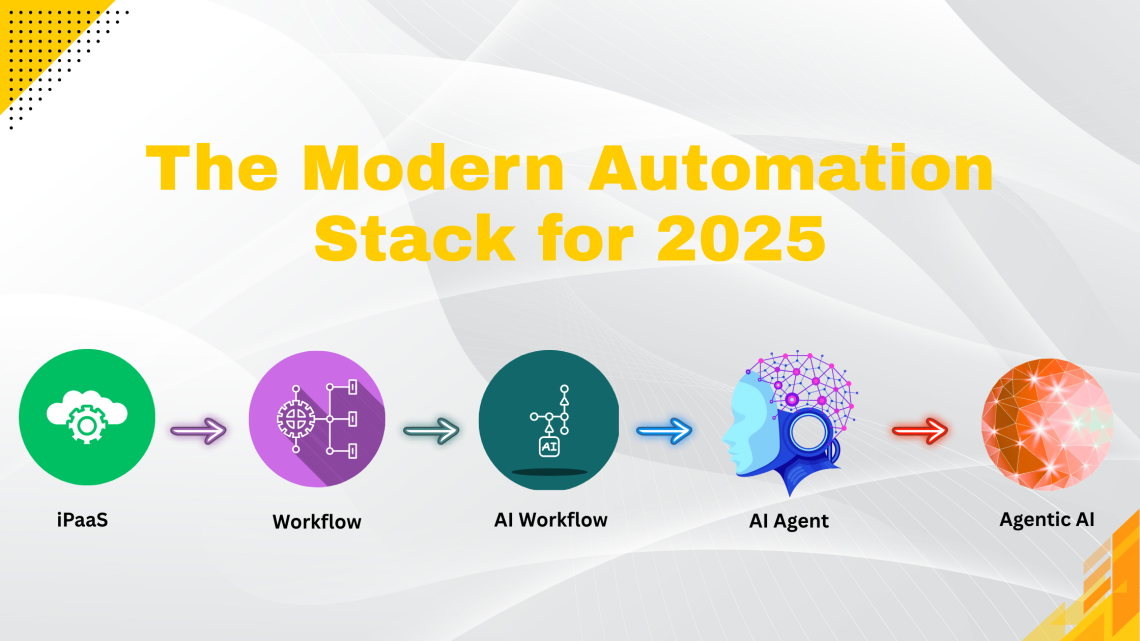
How the 2025 Automation Stack Works: iPaaS, Workflows, AI, and Agentic AI Explained
November 12, 2025Quick Summary – Modern Automation Stack for 2025
Start with an iPaaS to unify connectivity and data transformation. Add Workflow Automation for predictable tasks. Use AI Workflow Automation to convert unstructured inputs into structured decisions. Deploy AI Agents when steps depend on context. Finally, scale to Agentic AI to complete end-to-end outcomes across teams.
Platform overview
Why This Guide on the Modern Automation Stack?
If your organization runs on a tangle of SaaS apps, legacy systems, CSV drops, and heroic spreadsheets, “just add AI” won’t fix it.
What will help is a Modern Automation Stack — a layered approach with clear responsibilities:
-
Connect & clean the data.
-
Automate the routine steps.
-
Apply AI where human interpretation slows down workflows.
-
Introduce agents when decisions can’t be hard-coded.
-
Orchestrate multiple agents for complete outcomes.
This guide breaks down each layer, adds practical examples, and links to deeper explainers — so you can implement quickly without reinventing the wheel.
Modern Automation Stack – The Five Layers at a Glance
| Layer | What It Does | Best for | Inputs | Outputs | Learn More |
|---|---|---|---|---|---|
| iPaaS | Connects apps/DBs/files; transforms & governs data | Enterprise integration at scale | DB/JDBC, FTP/SFTP, REST/SOAP | Synced records, API calls | Guide · eZintegrations™ |
| Workflow Automation | Deterministic triggers → actions | Approvals, notifications, SaaS-to-SaaS tasks | Webhooks, schedules | CRM updates, Slack, tickets | Guide · eZintegrations™ |
| AI Workflow Automation | Adds LLM steps inside workflows | Unstructured → structured | Emails, PDFs, chats | Validated JSON, summaries | Guide · eZintegrations™ |
| AI Agent | Chooses next best step with planning & tools | Context-heavy tasks | Mixed & contextual | Actions, insights | Guide · Goldfinch AI |
| Agentic AI | Orchestrates multiple agents under a controller | End-to-end outcomes | Multi-system | Completed workflows | Guide · Goldfinch AI |
1. iPaaS – Your Integration Backbone
An iPaaS is the foundation of the Modern Automation Stack. It connects databases, APIs, FTPs, and webhooks, handling mapping, transformation, validation, and business rules with built-in observability.
Use Cases:
-
Order-to-Cash automation
-
Customer 360 dashboards
-
Marketplace operations (Amazon/Walmart SP-API)
-
Healthcare interoperability (HL7/FHIR)
Learn more: What is iPaaS?
2. Workflow Automation – Let Robots Handle Routine Tasks
Workflows are triggers → conditions → actions. Perfect for repeatable, deterministic processes in sales, support, and finance.
Read: Workflow Automation Guide
3. AI Workflow Automation – When Inputs Get Messy
Add AI steps inside workflows to process unstructured data (emails, PDFs, chats) into validated, structured outputs.
Industries: Finance, Healthcare, HR, Legal.
Explore: AI Workflow Automation
4. AI Agents – From “Do Steps” to “Decide Next Step”
Agents bring adaptability and intelligence to your stack — ideal for contextual tasks like incident triage or finance reconciliation.
Discover: AI Agent Explained
5. Agentic AI – Orchestrate Teams of Agents
Agentic AI coordinates specialized agents under one controller to deliver complete outcomes.
Industries: SaaS, eCommerce, Healthcare, Security.
Learn more: Agentic AI Overview
Modern Automation Stack Adoption Roadmap (90 Days)
-
Weeks 1–3: Stabilize data via iPaaS
-
Weeks 2–5: Automate the routine with Workflows
-
Weeks 4–7: Add AI Workflow Automation
-
Weeks 6–9: Pilot an AI Agent
-
Weeks 8–12: Scale to Agentic AI
Modern Automation Stack KPIs That Matter
-
Integration reliability (success %, latency)
-
Workflow automation impact (cycle time, SLA adherence)
-
AI precision and cost per artifact
-
Agentic outcomes (end-to-end success rate)
Product Fit
eZintegrations™ → iPaaS • Workflow • AI Workflow
Goldfinch AI → AI Agents • Agentic AI
FAQs
The Modern Automation Stack is a multi-layered framework that integrates applications, automates workflows, and leverages AI for decision-making. It combines iPaaS, Workflow Automation, AI Workflows, AI Agents, and Agentic AI to create a unified automation ecosystem.
In 2025, organizations operate across multiple systems and platforms. The Modern Automation Stack helps simplify integrations, streamline workflows, and enable intelligent, context-aware automation that scales efficiently across business operations.
The Modern Automation Stack includes five key layers: iPaaS for integration, Workflow Automation for process management, AI Workflow Automation for intelligent data handling, AI Agents for adaptive decision-making, and Agentic AI for orchestrating complete outcomes.
Traditional automation is rule-based and rigid, while the Modern Automation Stack uses AI and machine learning to adapt dynamically, interpret data, and make context-driven decisions without constant human intervention.
The key benefits include improved data connectivity, faster process execution, enhanced decision-making through AI, reduced operational costs, and scalable automation across departments and industries. 1. What is the Modern Automation Stack?
2. Why is the Modern Automation Stack important in 2025?
3. What are the main components of the Modern Automation Stack?
4. How is the Modern Automation Stack different from traditional automation?
5. What are the key benefits of implementing the Modern Automation Stack?
